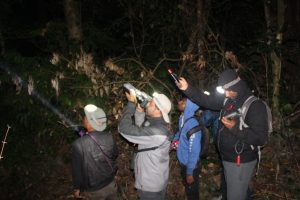Guwahati, Dec 21: Little is known about the Namdapha flying squirrel since it is an arboreal and a nocturnal species endemic to Arunachal Pradesh in northeastern India.
Given that it looks very similar to the Red giant flying squirrel, also is distributed in Arunachal Pradesh, it becomes a challenging task to distinguish between the two.
However, there has been constant toiling among conservationists hailing from different organizations to search for this mystical species that was last described in 1981 based on a single individual. After multiple failed expeditions in search of this enigmatic mammal, one of India’s leading wildlife NGOs, Aaranyak started off their search with 10 expeditions for a total of 79 days around March 2021.
Aaranyak’s team designed their study plan strategically by aiming to determine the particular habitat used by the evasive mammal during the first few months to curtail the effort of the team in unpopulated areas. This strategy was advantageous to the team in comparison to the previous teams who looked for the species in areas where they were unlikely to be found.

Aaranyak’s team led by Dr. Firoz Ahmed, includes Sourav Gupta, a field researcher and Sourav Mardi, a volunteer, who conducted a series of nightly visits to various potential sites which they found to be upper forest canopies close to the river. Tajum Yomcha, Research Officer, Forest Department of Arunachal Pradesh has been a field mentor to the Aaranyak team and contributed to the search and find of this elusive species.
Finally, in April of 2022, Aaranyak’s team of researchers sighted a reddish and grizzled furry small mammal high up in the tree canopy. After months of scrutiny of the photographic evidence that they gathered, experts have been pretty sure of its identity as the Namdapha flying squirrel. However, such morphological evidence through images does not conclusively confirm a species until corroborated with DNA analysis.
Currently, Dr Ahmed and his team are designing a study to collect DNA samples of the squirrel in the field and later comparing the genetic material to the DNA of the individual collected in 1981 that has been stored in the Zoological Survey of India, Kolkata, India.
“Flying squirrels are majestic animals and both Namdapha flying squirrel and Red giant flying squirrel make Namdapha National Park much more special,” Dr Ahmed says.
“If we find the Namdapha Flying Squirrel, it will be a powerful flagship for conservation for both the park and other wildlife found here. And a great story of hope for the conservation of all the other most wanted lost species,” he further said.
The sighting and photographic evidence of the Namdapha flying squirrel by the competent team of Aaranyak’s biologists in an inhospitable terrain like that of Arunachal’s Namdapha National Park, along with the never-ending funding crunch, counts to be a major accomplishment in rediscovering a species that was long thought to be lost or that remained a species of mystery all this while. The team would continue its search for the elusive nocturnal denizen of Namdapha and conclude its identity with additional evidences soon.
“Our team was well aware that tracking down the elusive species, missing for 42 years with no live observations or photographs, and a complete absence of information, mirrored the difficulty of finding a needle in a haystack. Notwithstanding the formidable task, the pursuit became enjoyable as we followed the glowing eyes in the dark. We are eagerly looking forward to securing DNA confirmation for the species,” researcher Sourav Gupta said.
The rediscovery of this critically endangered species is expected to instill a ray of hope for conservationists to further work on the species’ ecology, habitats, demography and genetics for their future survival.
The Aaranyak study was supported by Re:Wild and IUCN SSC Small Mammal Specialist Group (SMSG) through donations and a crowd funded project initiated in 2019.



